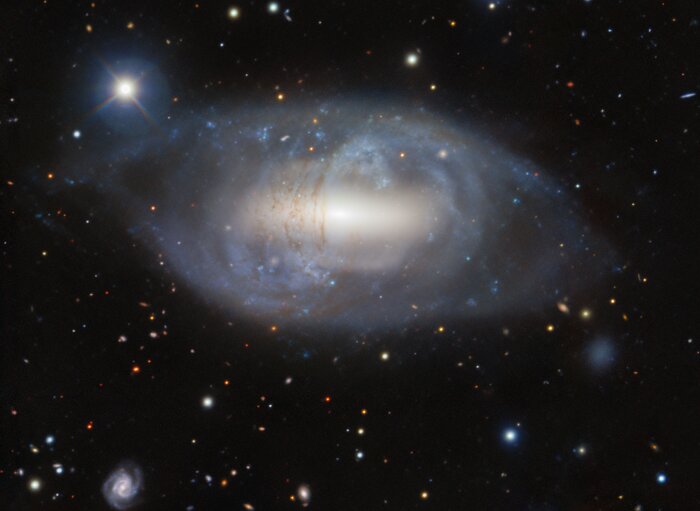NGC 2685: A Helix in the Sky
The very unusual galaxy NGC 2685, also known as the Helix Galaxy, is located about 40 million light-years away in the constellation Ursa Major. This image was captured by the Gemini North telescope, one half of the International Gemini Observatory, operated by NSF NOIRLab which is funded by the U.S. National Science Foundation. NGC 2685 is a peculiar lenticular galaxy known as a polar ring galaxy. A ring of gas, stars, and dust orbits NGC 2685 perpendicular to the flat plane of the host galaxy. This odd crossing of planes is believed to be evidence of galaxy interactions, mergers, or tidal accretion events. Current research suggests that the present structure of NGC 2685 was formed when it captured material from another galaxy, which was strung out into an encircling ring. This galaxy is one of our closest known polar ring galaxies and is therefore one of the easiest of its kind to study. Owing to its odd characteristics, it has been called the most unusual galaxy in the Shapley-Ames Catalog of Bright Galaxies and appears as number 336 in astronomer Halton Arp's Atlas of Peculiar Galaxies.
You can see another view of this galaxy, captured in 1998 by the 0.9-meter telescope of Kitt Peak National Observatory, a Program of NSF NOIRLab, here.
Credit:International Gemini Observatory/NOIRLab/NSF/AURA/L. Bassino
Image processing: J. Miller (Gemini Observatory/NSF NOIRLab), M. Rodriguez (Gemini Observatory/NSF NOIRLab), & M. Zamani (NSF NOIRLab)
About the Image
| Id: | iotw2415a |
| Type: | Observation |
| Release date: | April 10, 2024, noon |
| Size: | 2495 x 1821 px |
About the Object
| Name: | NGC 2685 |
| Distance: | 40 million light years |
| Constellation: | Ursa Major |
| Category: | Galaxies |
Wallpapers
Coordinates
| Position (RA): | 8 55 36.53 |
| Position (Dec): | 58° 43' 43.67" |
| Field of view: | 6.72 x 4.90 arcminutes |
| Orientation: | North is 50.0° left of vertical |
Colors & filters
| Band | Wave-length | Tele-scope |
|---|---|---|
| Optical g | 475 nm | Gemini North GMOS-N |
| Optical r | 630 nm | Gemini North GMOS-N |
| Optical i | 780 nm | Gemini North GMOS-N |

